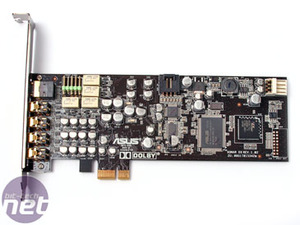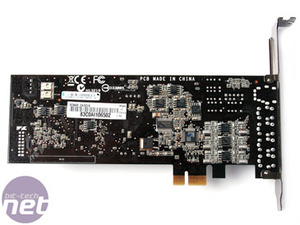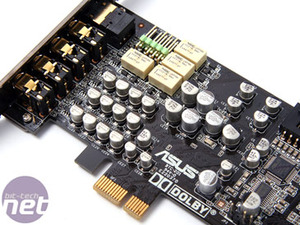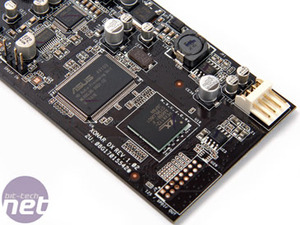
Hardware
Asus has changed the hardware on the DX slightly, instead of the AV200 chipset on the D2X we now have the AV100 – it’s still the same CMedia Oxygen HD chipset we first saw way back in 2006 on the Sondigo Inferno 7.1, which makes it the same chipset as the AV200. The difference is that Asus claims it hand picks the best chips and labels them AV200 to ensure better quality, however others dispute this fact - stating that they either work or they don't as simple digital processors and the analogue processing is done elsewhere.The Digital to Analogue converters are no longer the 123dB SNR Burr Brown made by Texas Instruments, instead the task is split between two Cirrus Logic chipsets: the CS4398 (front) and the CS4362A (centre, side and rear). This is because the front channels have a (quoted) SNR of 116dB and the rest are 112dB – in comparison the D2X had 118dB all round.
This is still significantly more than on-board audio can muster as it often struggles to scratch at 90dB for even the best chipsets and most expensive boards. In comparison, Creative uses a single Cirrus Logic chipset, the CS4382, which supplies all channels with 114dB SNR on its XtremeGamer.
Digging out the specification for these parts, Cirrus Logic rates these as 118dB and 114dB respectively, so it looks like Asus’s use in the Xonar DX is just 2dB less.
So, if you’re a heavily into your surround sound then Creative might be fractionally better—at least on paper—but if headphones or a set of Stereo speakers suit your desktop better, then the Asus is probably the favoured choice. In reality though there will be no noticeable difference unless you’ve the most acute sense of hearing – something some of us might claim, but few of us music lovers actually have after years of abuse from Walkmans, iPods, night clubs, gigs and concerts.
If anything Asus’s approach is somewhat clever – while 7.1 or even 5.1 audio would be nice for all, we’d argue that few have the space for it around a PC desk and most of us opt for stereo (with sub) and/or headphones, therefore quality weighting the front two channels by using a single chipset for them does make sense makes perfect sense. Although, again, whether you'd notice the difference is questionable.
In terms of analogue recording, the Asus is on paper better kitted with its Cirrus Logic CS5361 which supports a higher frequency range of up to 24-bit/192KHz and a better SNR of 112dB compared to the XtremeGamer’s Wolfson Electronics WM8775 which is only 24-bit/96KHz at 102dB SNR.

Chipset pedants aside, the general package that Asus uses is simply better in every respect – the card uses an updated PCI-Express x1 interface and it specifically uses aluminium capped capacitors although whether they are solid electrolytic ones with a low ESR is questionable - Asus has claimed they are to us, while others have informed us they aren't - merely standard electrolytics that are surface mount for ease of application on the production line, and capped differently.

MSI MPG Velox 100R Chassis Review
October 14 2021 | 15:04












Want to comment? Please log in.